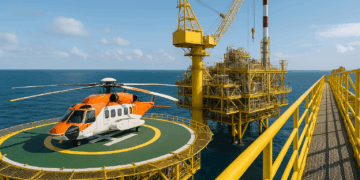Story Highlight
– North Sea oil workers must meet new weight limit.
– Maximum weight set at 124.7kg for safety reasons.
– Over 2,200 workers exceed the new weight limit.
– Employers given a year to assist affected employees.
– Concerns raised about fit workers over the weight limit.
Full Story
Workers in the North Sea oil sector face new weight restrictions aimed at enhancing safety procedures during offshore operations. Starting from November next year, Offshore Energies UK (OEUK) will implement a maximum weight limit for workers, set at 124.7 kg while clothed. This decision stems from a need to ensure that personnel can be safely winched to safety by emergency rescue helicopters in critical situations.
A typical coastguard helicopter has a weight capacity of 249 kg, which must accommodate not only the workers but also an average rescuer, whose weight is approximately 90.3 kg, along with necessary equipment weighing around 5 kg, and a stretcher adding another 29 kg. The safety initiative underscores the importance of ensuring that all workers can be rescued effectively, which is a critical aspect of offshore safety protocols.
According to OEUK, last year, 2,277 offshore workers exceeded this new weight threshold. Following a comprehensive evaluation that spanned over two years, the organisation deemed it necessary to establish this weight limit, after exploring various alternatives. The introduction of the measure aims to create a safer environment for all personnel involved in offshore operations.
As stated by Graham Skinner, the health and safety manager at OEUK, the industry is committed to supporting those workers affected by the new regulations over the next year. Skinner conveyed to the BBC his concerns regarding potential job losses as a result of the new policy. He remarked, “That would be the absolute worst-case scenario,” emphasising the responsibility employers have to assist their staff in achieving the weight requirements by the deadline.
A pivotal aspect of the initiative revolves around fostering a collective movement towards meeting these limits. Skinner indicated that it’s vital to embed this message within the culture of the workplace as a means of motivating individuals to pursue weight loss in line with the policy timeline. Workers who do not meet the stipulated weight limit will face difficulties in passing necessary medical assessments, which would consequently preclude them from boarding helicopters for offshore work.
The decision to publicise the policy this year has been strategically made to allow employers sufficient time to prepare their teams, offer necessary support, and address any concerns raised by the workforce. The weight limit policy was introduced following consultations with the Maritime and Coastguard Agency, and is scheduled to take effect on November 1, 2026.
During an appearance on BBC Radio Scotland’s Good Morning Scotland programme, Skinner mentioned that an additional 2,500 offshore workers currently fall below the weight cap but may still require further assistance or weight management support. This indicates that upwards of 5,000 workers may be affected in varying degrees by the impending changes.
John Boland, a regional officer with the Unite union, highlighted the necessity for supportive measures to help workers navigate these new regulations. He expressed that there are valid concerns from individuals who are of a larger build but are nonetheless fit and capable, yet find themselves above the new weight limit.
The implementation of these changes poses a significant challenge for both employees and employers in the rapidly evolving landscape of the offshore energy sector. Practically, this will require concerted efforts aimed at enhancing health and wellbeing, potentially involving fitness programmes, counselling, and other support mechanisms to help individuals achieve the desired outcomes.
As the industry prepares for this transition, open communication between workers and management will be crucial in addressing concerns and ensuring that safety standards are met without compromising the livelihoods of those involved in the North Sea oil operations. The coming year will be pivotal in establishing effective strategies to help workers adapt to these new guidelines while maintaining a high standard of safety.
































Safety is paramount in offshore operations and any measure that improves survival chances in an emergency deserves careful consideration. That said, setting a strict weight ceiling raises real concerns about fairness, confidentiality and the risk of penalising workers for health issues that may be complex to address quickly. Employers should use the transition year to offer confidential support including medical assessment, structured health and fitness programmes, reasonable adjustments where possible and clear redeployment pathways. Unions and operators must engage transparently so solutions protect both safety and livelihoods rather than simply excluding experienced staff.
Safety must come first but the human impact cannot be ignored. Any rule set to protect crews and rescue teams is sensible, yet employers and industry bodies must offer practical help now: health and wellbeing support, medically supervised weight management, reasonable redeployment options and clear communication about timelines. Dismissal should be a last resort. Transparent risk assessments and consideration of alternative equipment or procedures where feasible could reduce job losses while maintaining rescue capability.